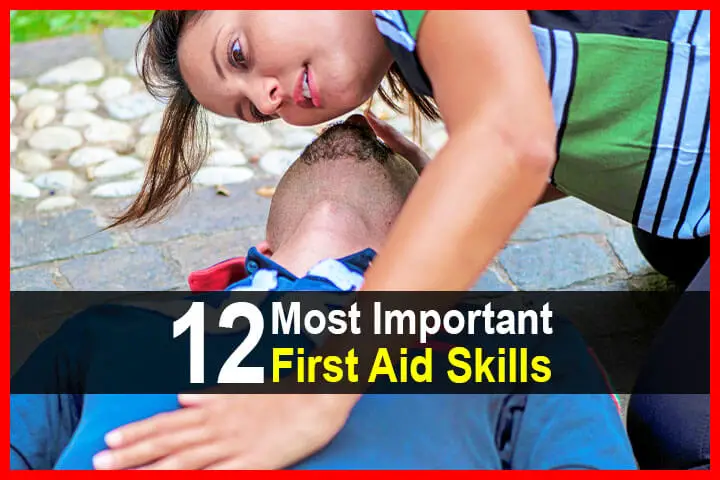Estimated reading time: 6 minutes
Disclaimer: I am not a medical doctor and nothing in this article should be taken as medical advice. Please talk to your doctor before using any of the herbs and/or remedies mentioned in this article.
After a major disaster, your survival is going to hinge on your skill set. While having a cache of food, water, and other supplies will certainly be helpful, knowledge is the real necessity. Especially when it comes to first aid.
All the medical supplies in the world are useless if you don’t know what to do with them. And believe me, during a widespread disaster, those medical supplies and first aid skills will be crucial.
With all the chaos that comes with disasters—debris, downed power lines, damaged buildings—people are bound to get hurt. And that includes you and your friends and family. Even a small, seemingly innocent injury can become serious if you don’t have access to clean water and medical help.
That’s why learning first aid skills should be a top priority when preparing for a disaster. If you’re not sure which particular skills to learn first, then I suggest working your way through the following list.
Want to save this post for later? Click Here to Pin It On Pinterest!
1. CPR
This is one of the most important and useful first aid skills you can ever learn. If you learned CPR over 5 years ago, you are in for a surprise. The standard for cardiopulmonary resuscitation has changed.
The process now excludes the breathing portion and focuses on chest compressions in what is known as hands only CPR. The strength of the compressions has also been changed, which lessens the risk of broken ribs and other serious injuries.
2. Making a Splint
A splint for a broken or sprained bone or joint will go a long way toward making a person feel better and keeping the injury from getting worse. Immobilizing a broken bone can be accomplished with a couple sticks and duct tape or a pillowcase or towel.
With the injured limb in a splint, the person will be able to move without causing more pain. Recovery time will be quicker, which is very important in a survival situation. A bone that heals incorrectly will either cause problems later or have to be broken again to allow for it to be set correctly. Just be careful.
3. Cleaning and Dressing a Wound
This can mean the difference between it healing quickly or becoming infected and deadly. How to irrigate a laceration and properly wrap it up will be extremely valuable information. In some cases, a butterfly stitch will need to be used to close a wound.
Here’s a step-by-step guide to wound care.
Another lifesaving trick you should learn. If someone is choking, you only have seconds to respond. Patting that person on the back isn’t going to help if something is lodged. The quick maneuver is effective and very easy to learn.
Wrapping your arms around the person while standing behind and making several swift jabs upward can help dislodge something that has blocked their airway.
5. Treating Shock
This is going to very useful, especially after some kind of traumatic event. Anybody is prone to shock, especially those who have been injured. The injury may be treated, but if the shock is ignored, the person will still die.
Learning how to recognize the symptoms and treat a person who is going into shock is extremely valuable information. Keeping a person calm, their feet elevated, and their body warm can help their blood pressure regulate, preventing it from dropping too low.
Stopping the bleeding and recognizing arterial bleeds is critical. Arterial bleeds can be fatal with the patient dying within a matter of minutes if the bleeding isn’t controlled. The bright red color is one of the most obvious signs.
Learn how to use pressure to stop the bleeding in combination with bandages to keep the person from bleeding out. A tourniquet is a last resort, but in the case of an arterial bleed, it is often the only option.
This is a dangerous condition that occurs often in a survival situation. Cold temperatures, no shelter, and inadequate clothing are common problems after a disaster. Knowing the signs of hypothermia and how to quickly treat it will save lives–maybe your own.
Also known as heat stroke. High temperatures are just as deadly as freezing temperatures. You need to know what to do when you or someone you are with starts to experience heat exhaustion. At the first sign of a headache, you need to get the person out of the heat.
Pushing fluids, placing a cool, damp cloth on the back of the neck and staying in the shade can help drop the body temperature quickly. You will only have a short time before the heat exhaustion leads to heat stroke, which can be deadly.
Here are 11 tips to avoid heat stroke.
This will likely come in handy in the midst and aftermath of a disaster. A burn can be life-threatening if it isn’t quickly treated. Depending on the severity of the burn, a person will lose several layers of skin that will leave them prone to infection.
You will need to know how treat a 2nd and 3rd degree burn with creams and how to bandage the burn to keep it protected without suffocating the area. Burn care is tricky and requires regular monitoring to make sure there are no signs of infection or skin death.
10. Identifying and Responding to Allergic Reactions
In a post-disaster scenario, unfamiliar triggers can cause allergic reactions. Symptoms can vary from mild rashes to severe anaphylaxis. Recognizing signs like difficulty breathing or swelling is essential. Knowing how to administer antihistamines or an epinephrine auto-injector can be life-saving.
11. Recognizing and Treating Dehydration
Limited access to clean water during disasters can lead to dehydration. Symptoms include dark yellow urine, extreme thirst, and dizziness. Understanding how to rehydrate someone, especially with oral rehydration solutions, is crucial to prevent severe complications.
12. Setting and Stabilizing Dislocations
Disasters can result in joint dislocations, causing immense pain and restricting movement. Recognizing a dislocated joint and knowing basic techniques to set it back in place can alleviate pain and prevent further injury. However, one should always seek professional medical help if possible after a makeshift intervention.
If you want to learn more about first aid, I highly recommend The Survival Medicine Handbook: A Guide for When Help is Not on the Way. It is easily the best first aid guide for beginners.
Like this post? Don’t Forget to Pin It On Pinterest!



















